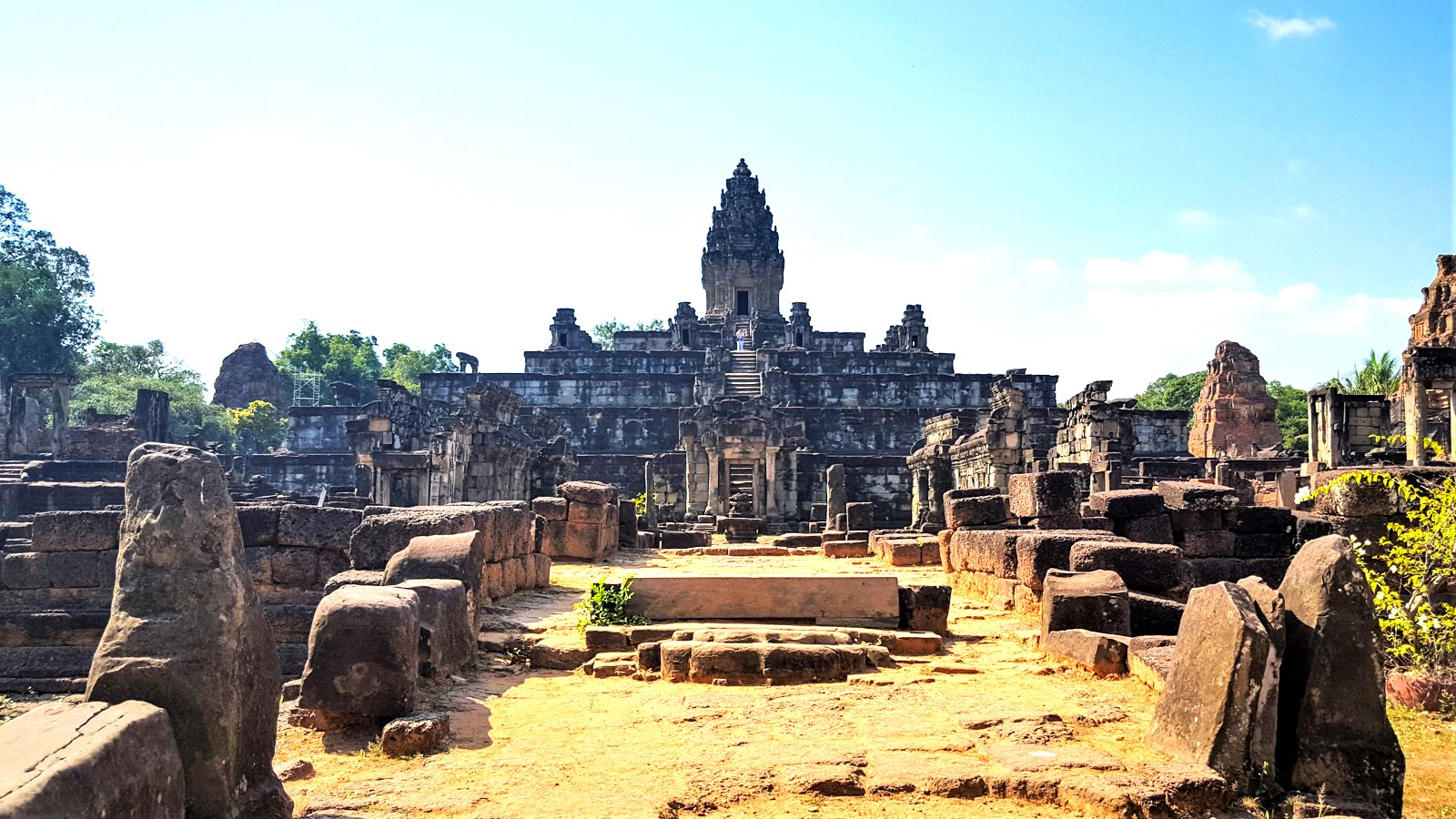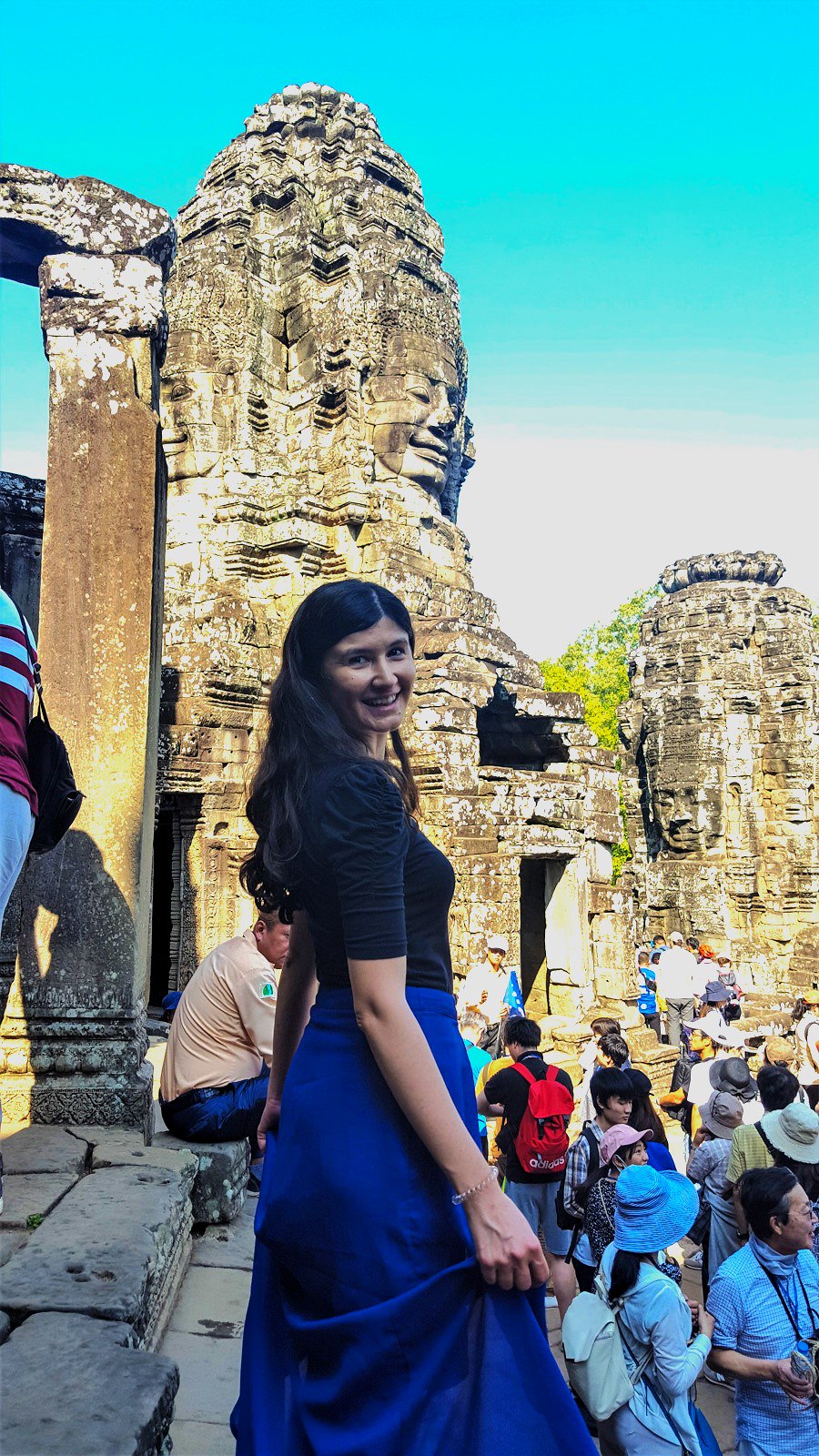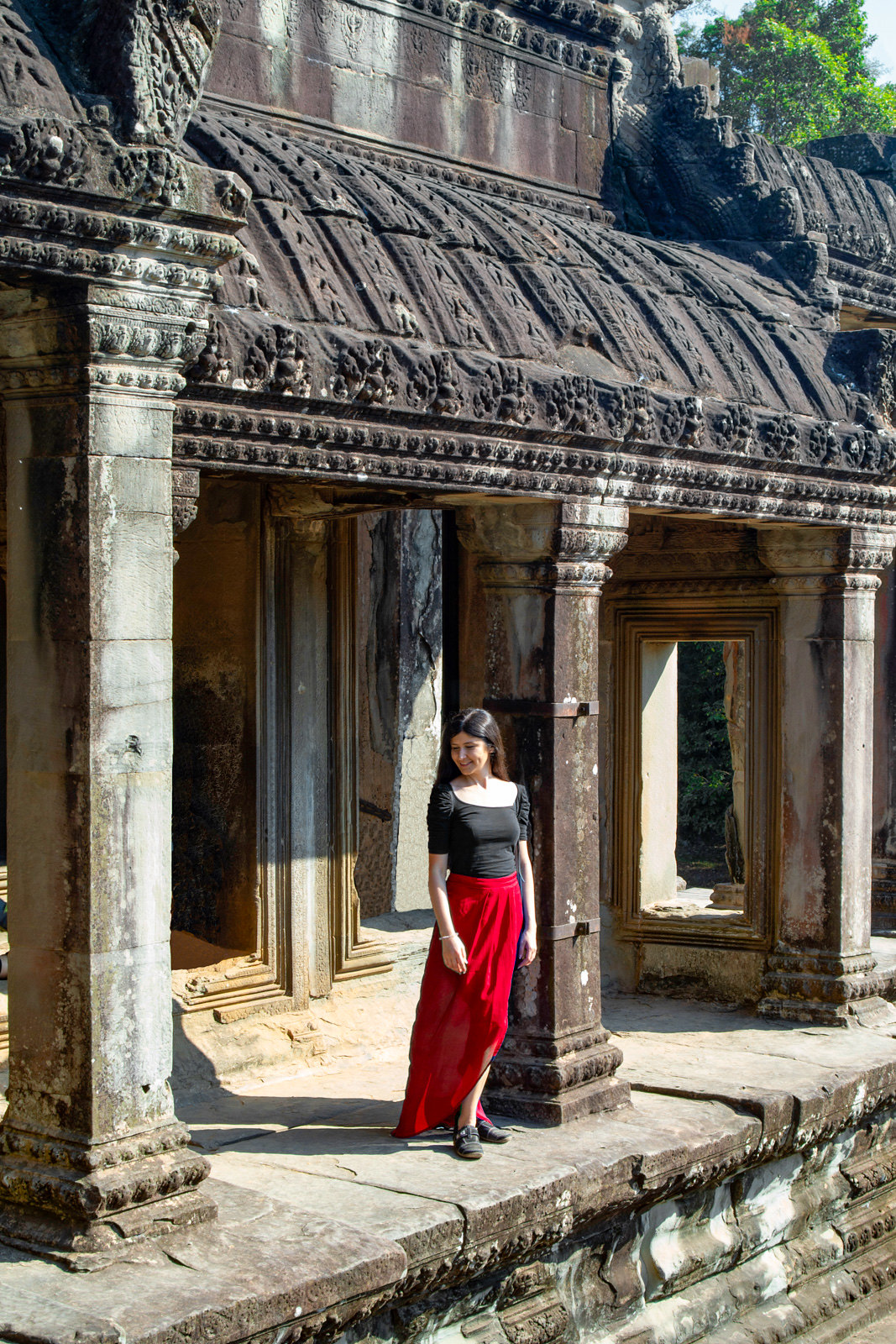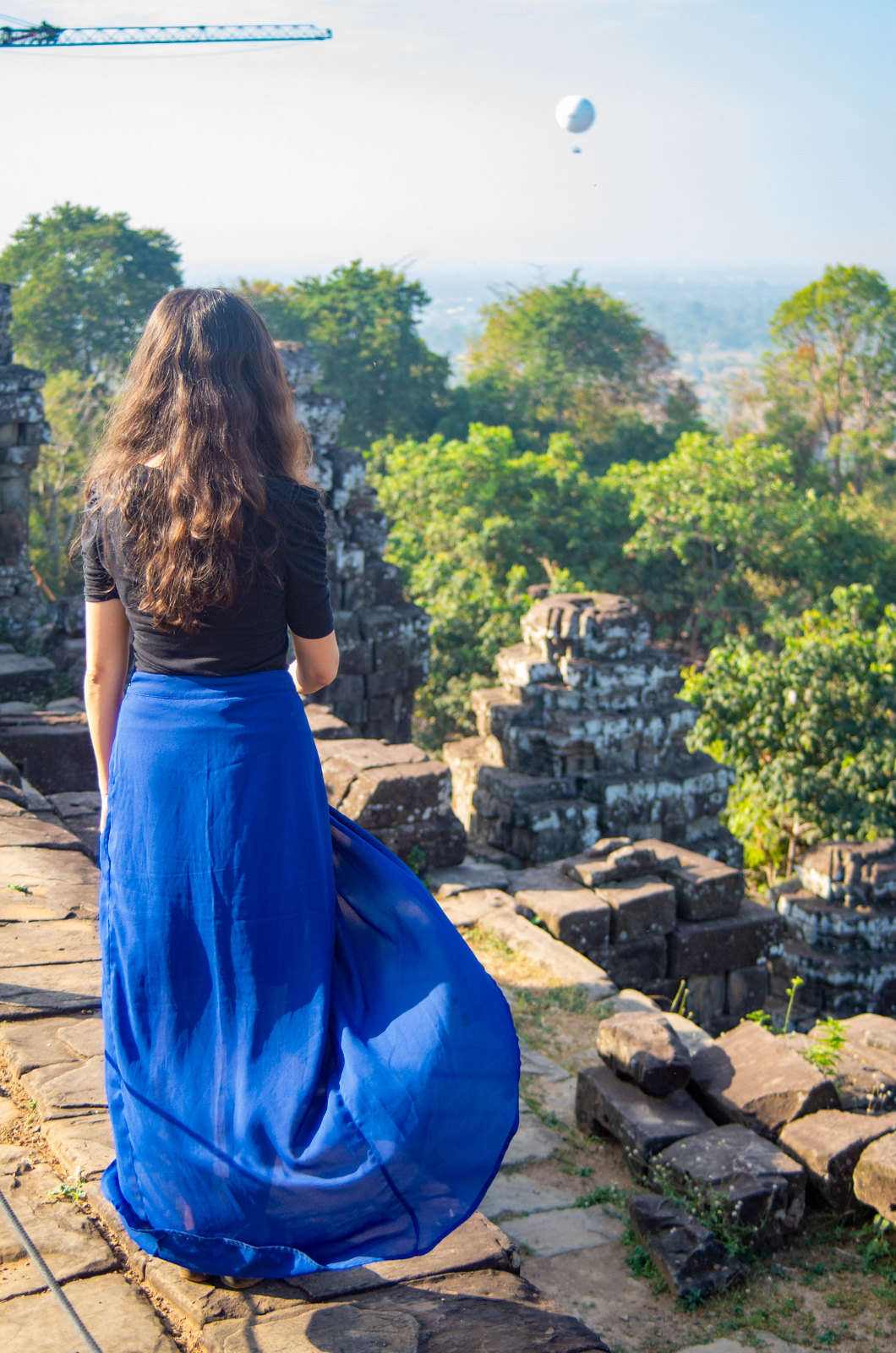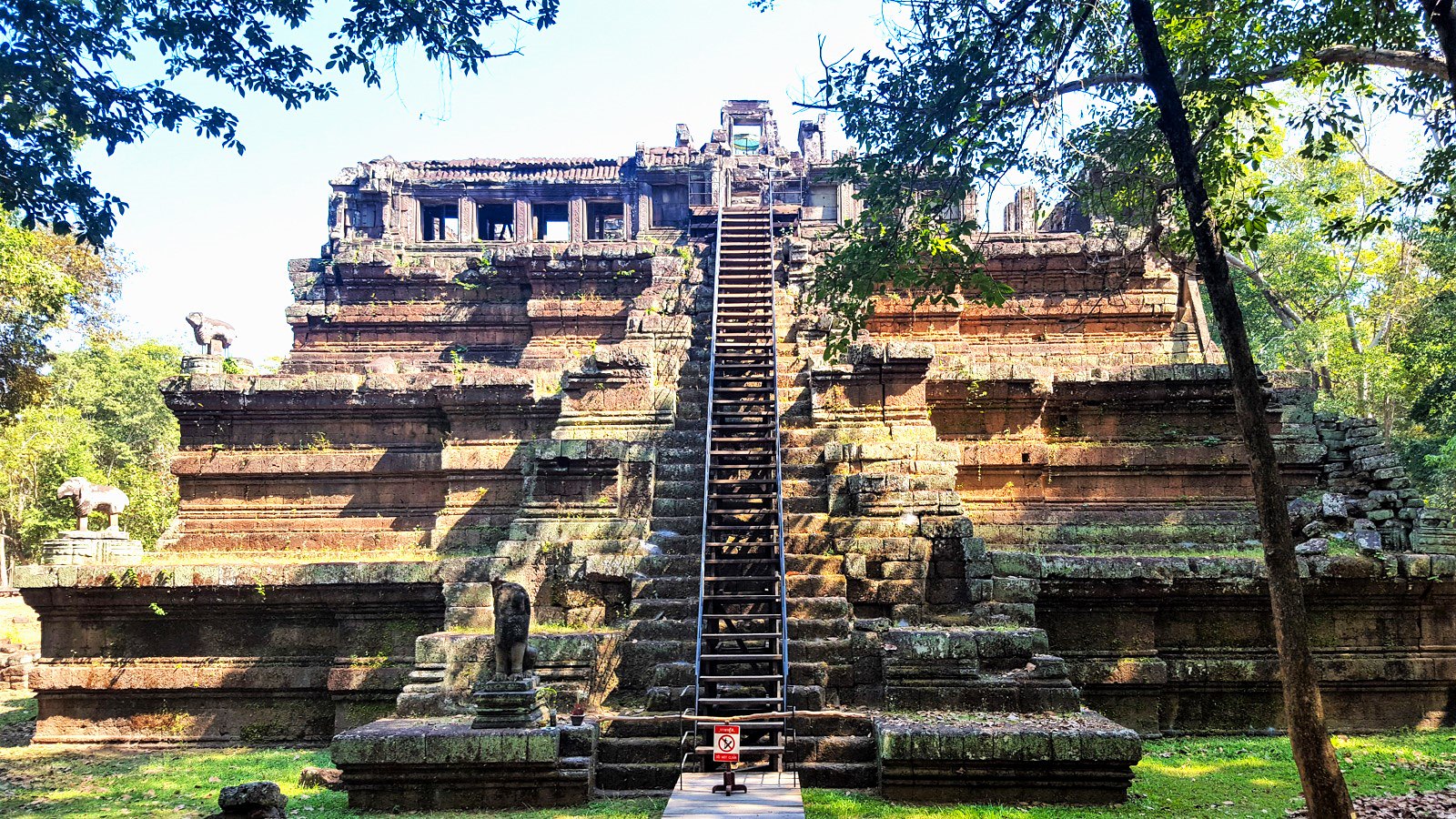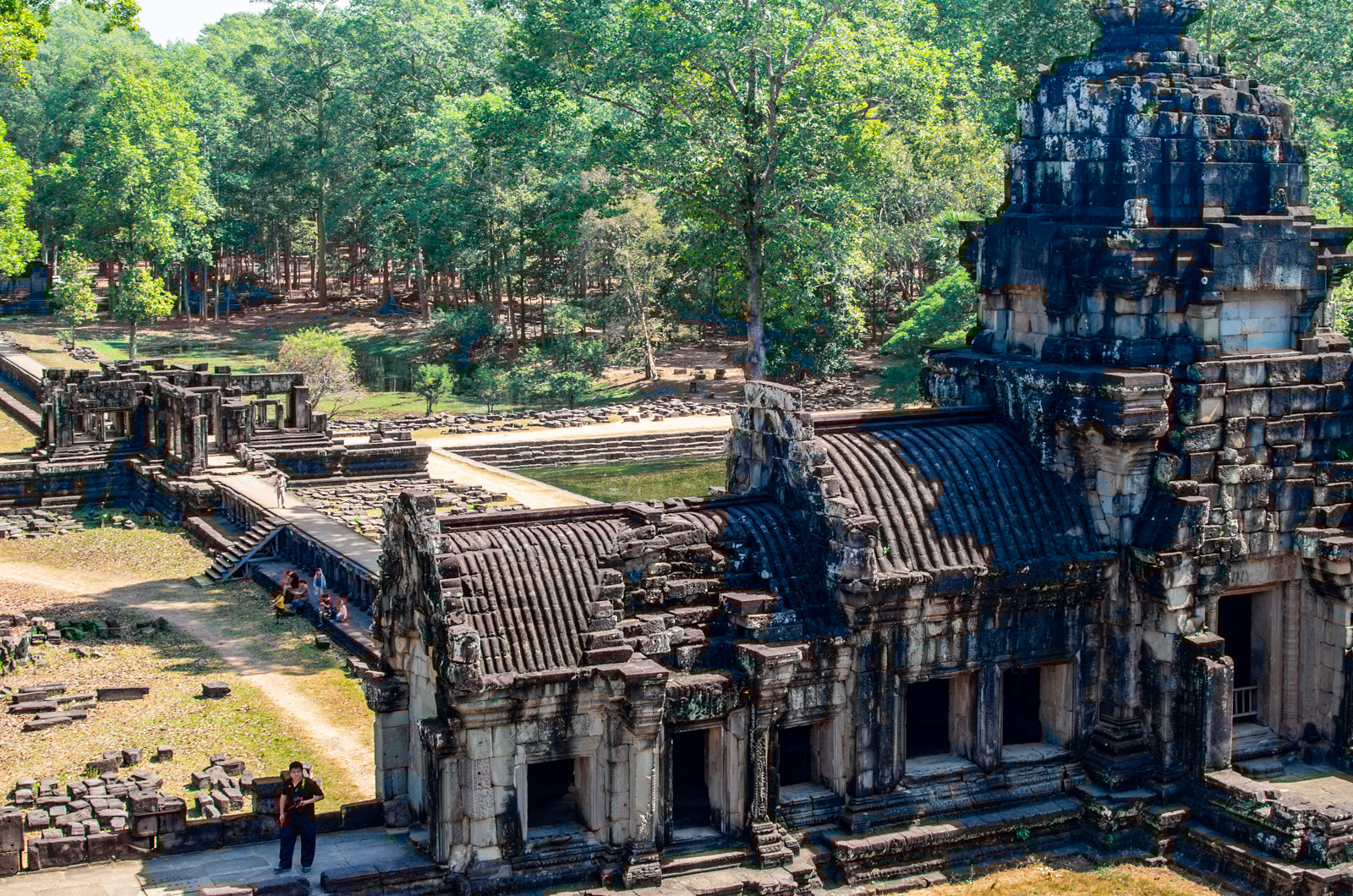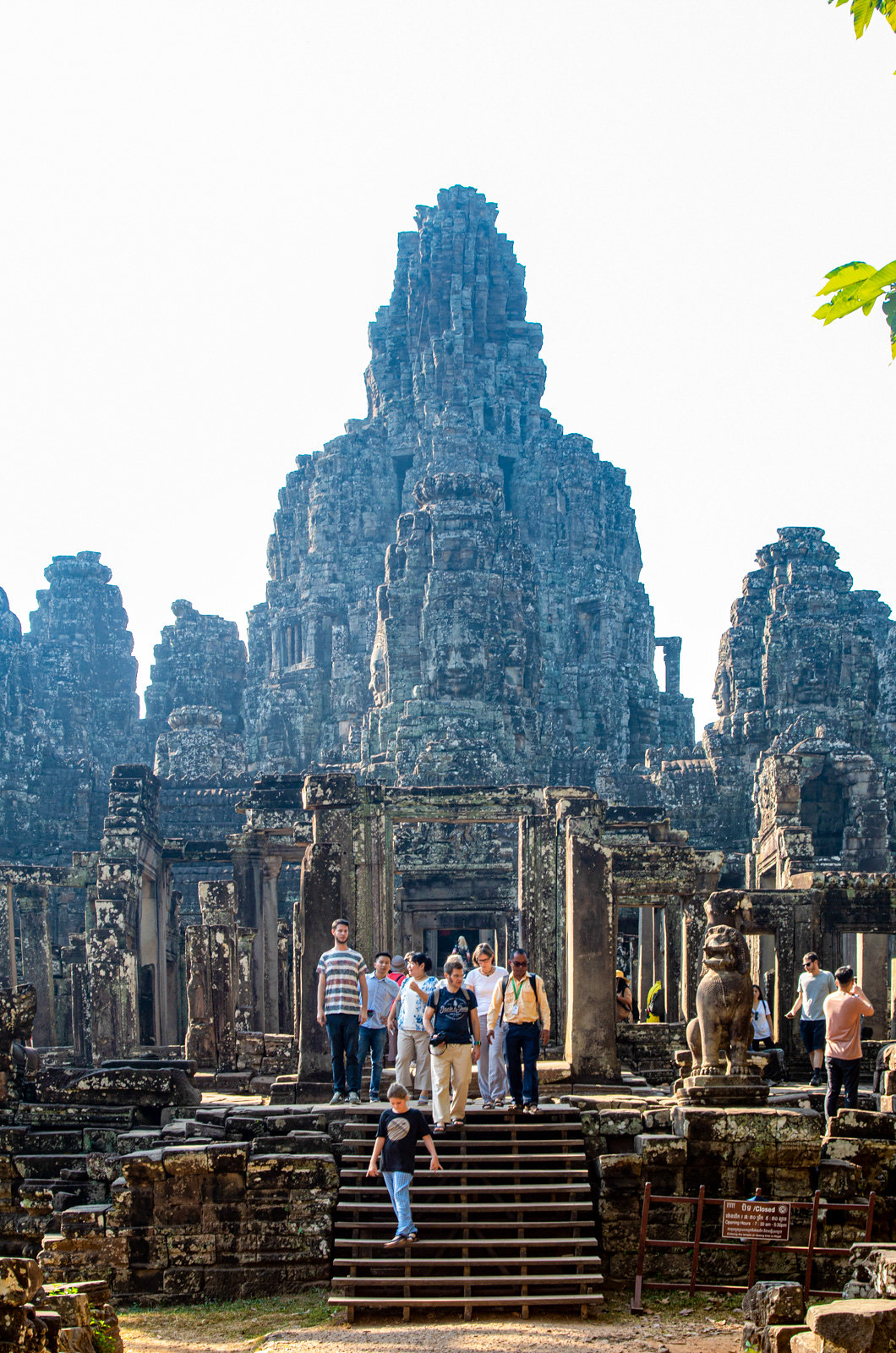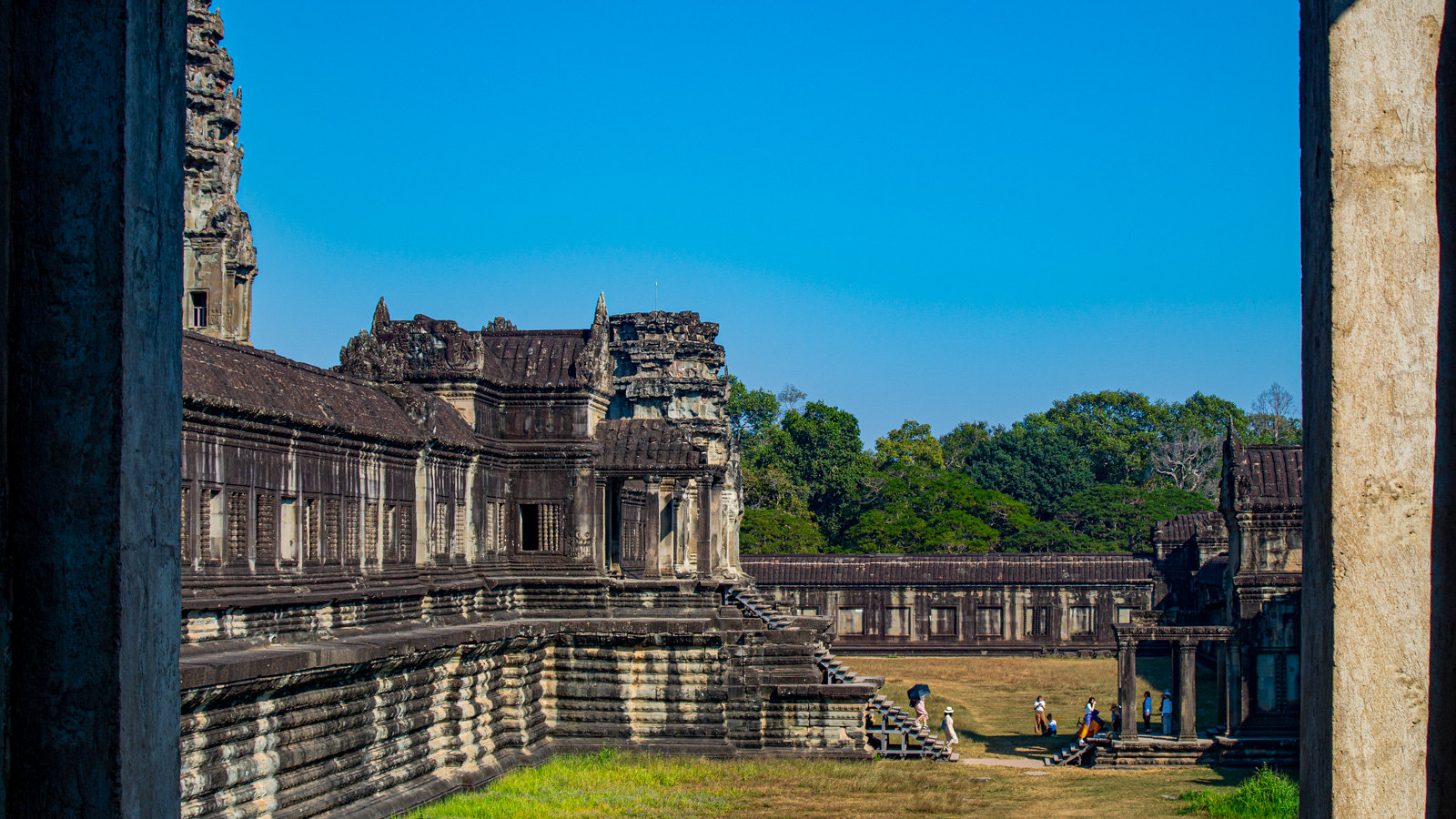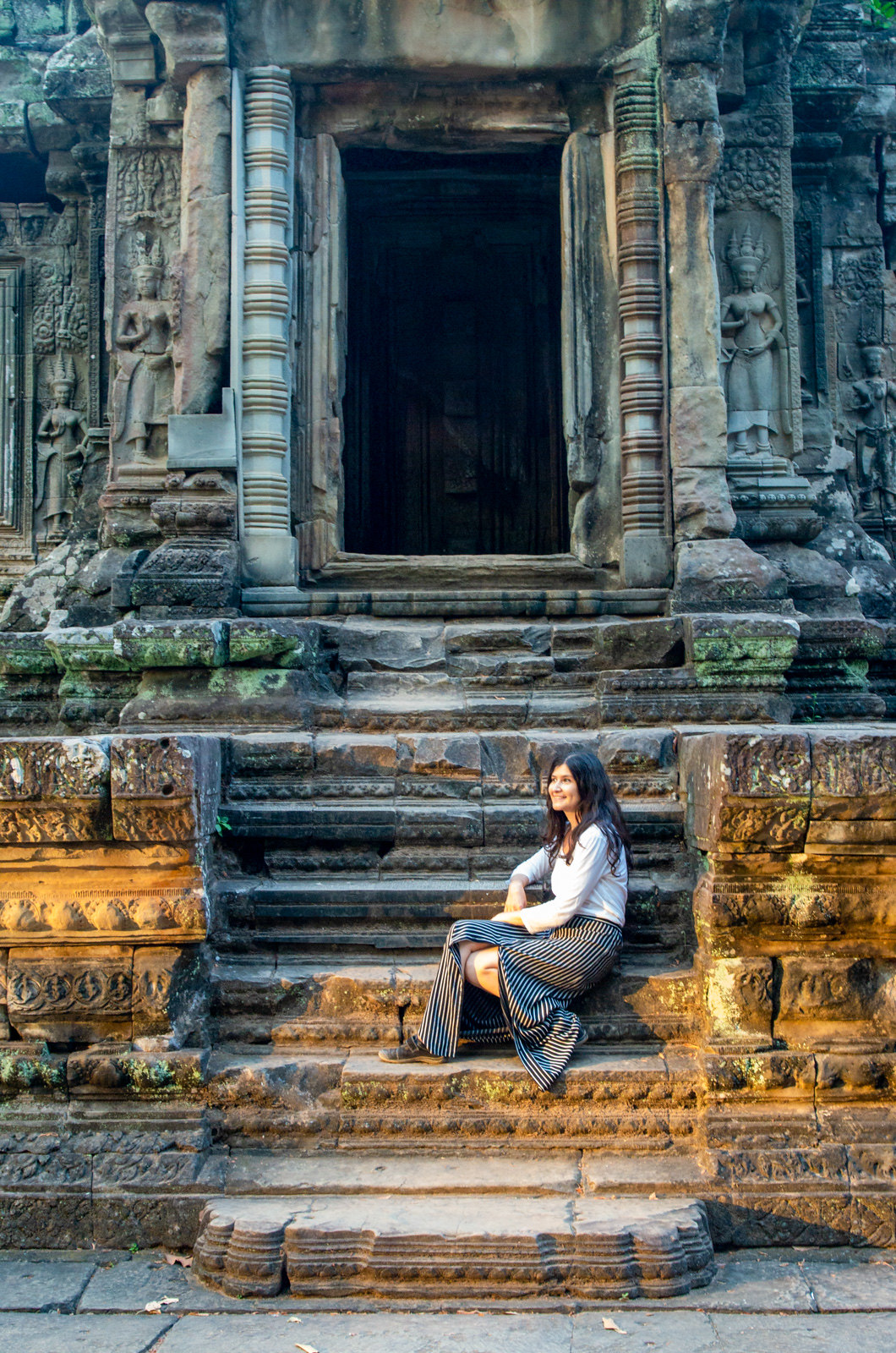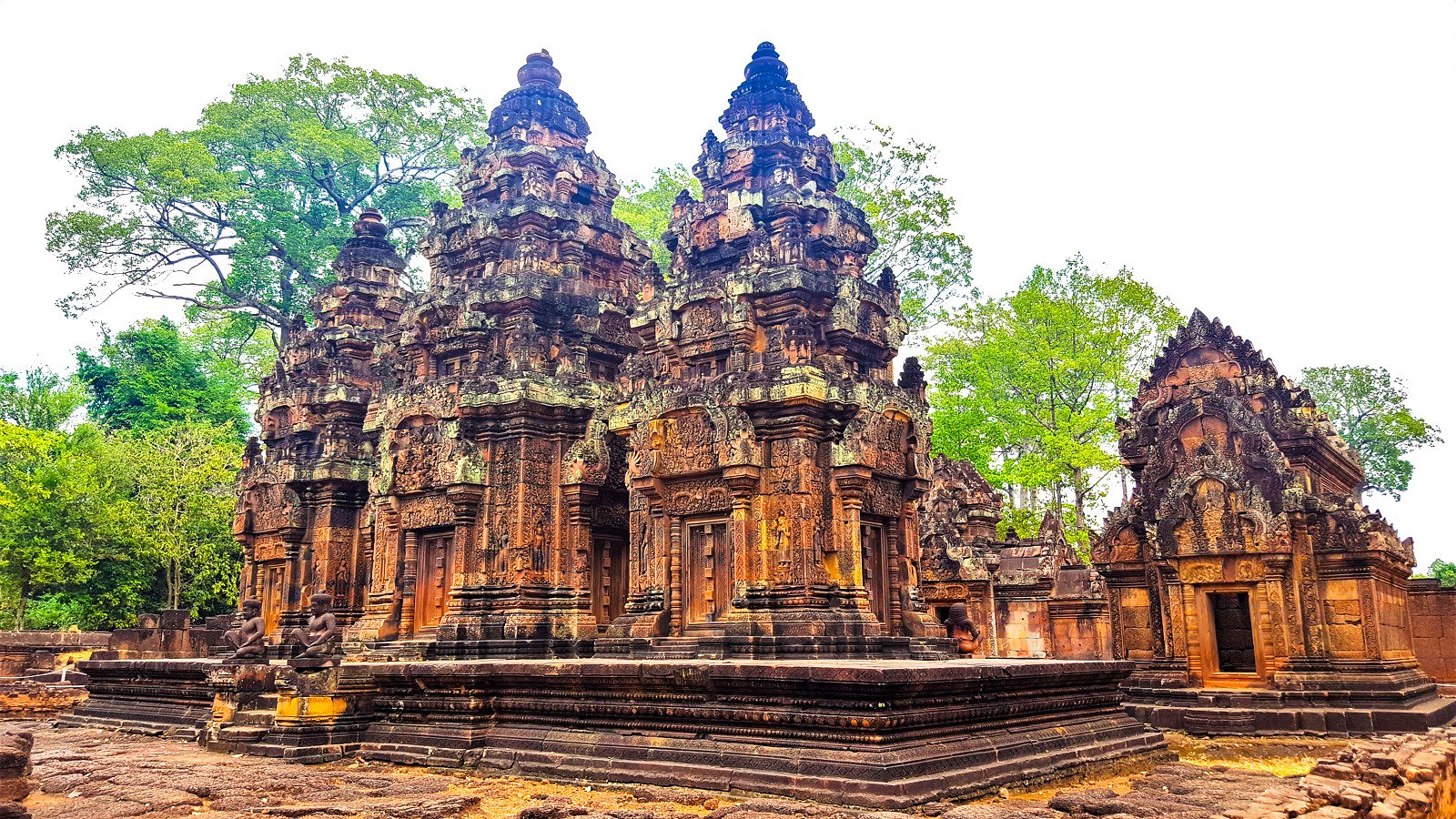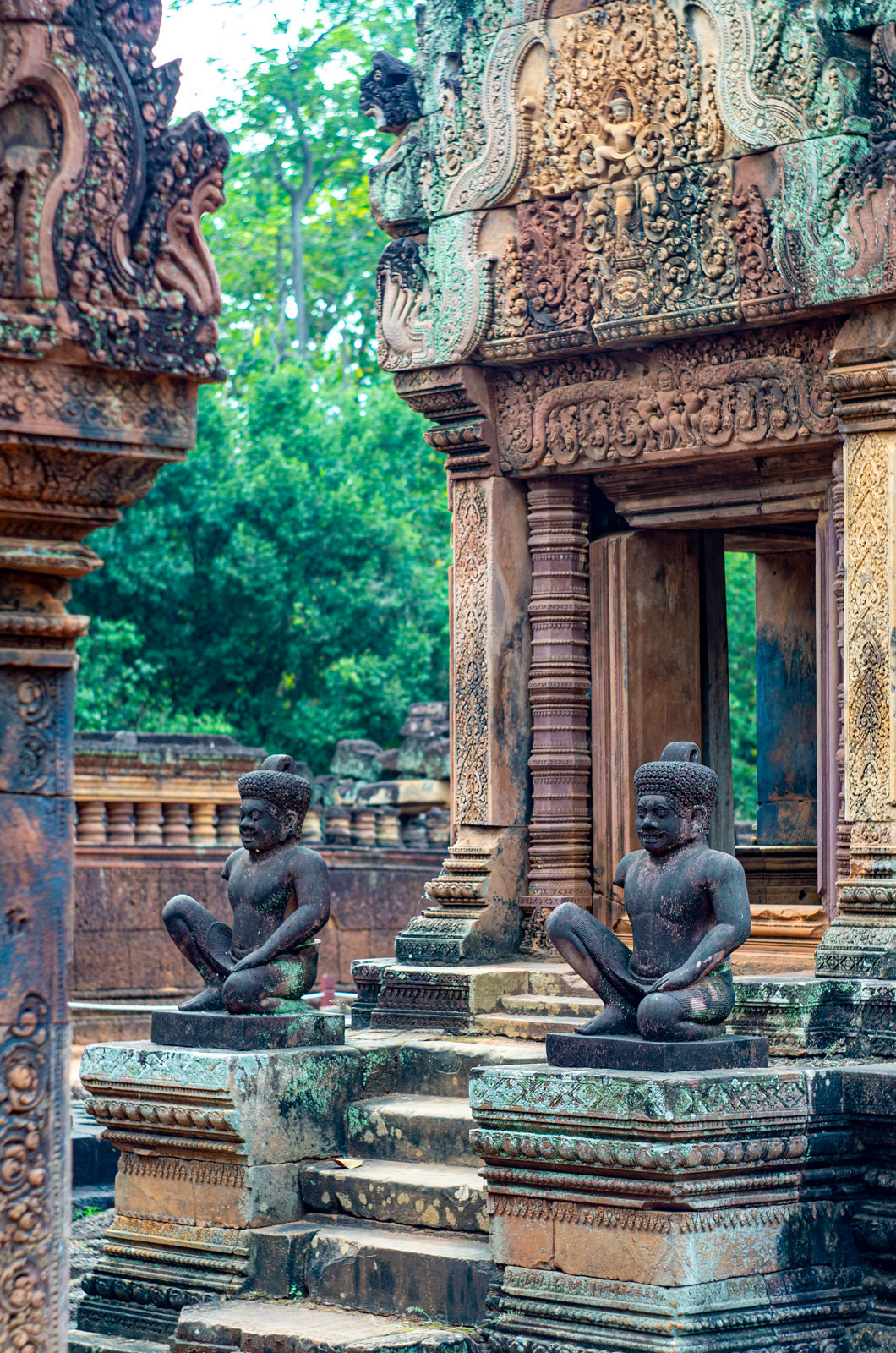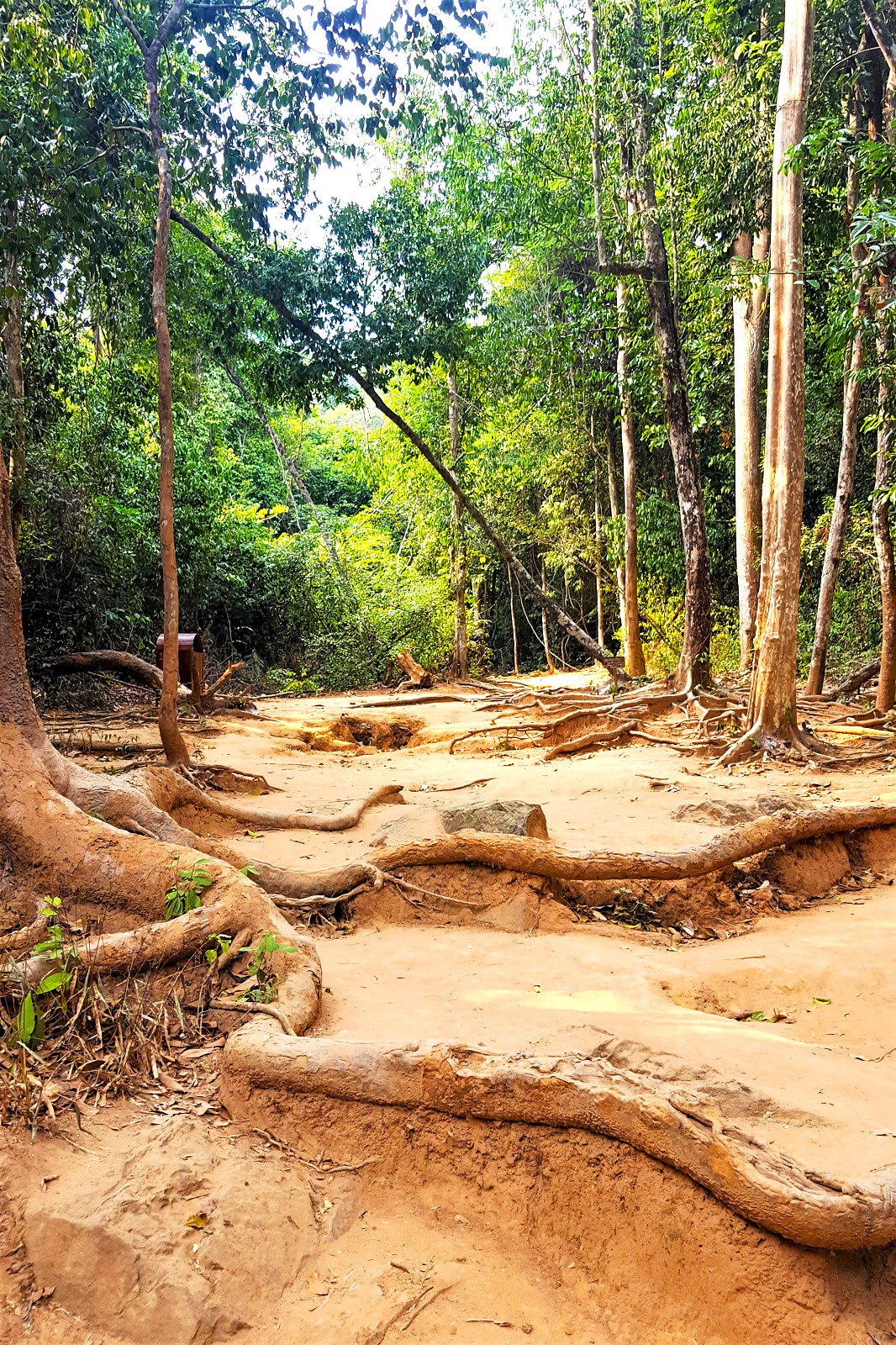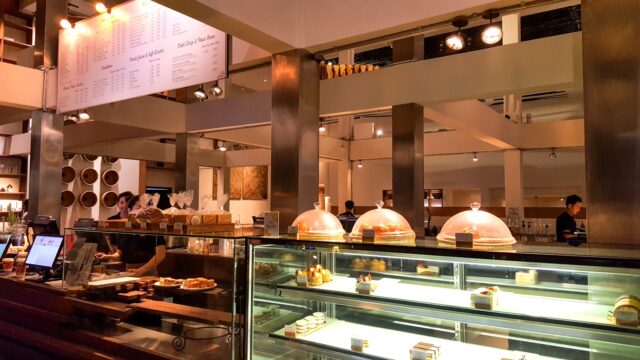Visiting Angkor was my dream for a while, but I had no clue, how vast this place was. While researching I found so many different recommendations about visiting it, I was quite confused. In the end, we ended up planning 4.5 days in Siem Reap, out of which 4 were allocated to Angkor. We bought 7-day pass for this. We definitely were happy that we had enough time.
Many people will tell you that “temple fatigue is real”, that you should take it easy and that you may get bored after a couple of days. Maybe it is true for some, but we definitely loved all of it and I would have done even more, so I guess it depends on your personality and how excited are you about climbing temples and visiting ruins.
Based on what we have seen and done, I have come up with the itinerary that may help you plan your trip. Certainly, you can play with this itinerary, leave out some temples to make it more relaxed or squeeze in even more. You can also do it in different order, than we did, but always keep in mind to find less crowded times for the most famous temples and to group the nearby temples together. Also, don’t forget to allocate enough time to the bigger temples, in order not to regret afterwards.
If you have only 1 day in Angkor, here is the itinerary for you.
If you need the tips and information about transport, clothes, entrance passes, etc., check here.
Is it possible to avoid the crowds?
Before I start, I want to give you some tips that may help you find some places slightly less crowded, than usual. I won’t create the expectation that you will have any of the major temples quiet. But in this case every little bit helps 🙂
Whichever mode of transportation you choose, you have an option of following the route set out on maps, which most tour groups follow. These routes are done that way, because they make the shortest driving time inbetween the temples and is somehow easier for drivers. However, if you, like us, hate too many tourists, especially the screaming tour groups (they are not always avoidable unfortunately), you may want to switch up that schedule a bit.
Every guide you read suggests to arrive early to beat the crowds, but the problem is that nowadays everyone reads those guides and, as most temples open at 7.30, they get crowded immediately after. So unless you are the first to enter, chances of having a quieter morning are slim. Try to avoid most crowded temples in the morning hours, especially from 8am to 12am. They are the most packed with tour groups. Especially the temples, with which the relevant circle tours start (they are called Small Circuit and Large Circuit and have set route for everyone).
My major tip is to visit lesser visited temples, particularly the ones at the end of usual tours, first. Then go to the most crowded of places, like Bayon and Ta Prohm around lunchtime, when most people go for, well, lunch 🙂 We did this at Ta Prohm, which is one of the most crowded spots and it really paid off. I don’t think you can have Angkor Wat even slightly less crowded any time of day, so just accept that you will enjoy it, while being around so many other people. It still is absolutely worth it.
The temples, which were the most fascinating for us
- Bakong
- Bayon
- Baphuon
- Ta Prohm
- Pre Rup
- East Mebon (loved the elephants)
- Angkor Wat
- Banteay Kdei
- Preah Khan (one of my favourates)
- Banteay Samre (this one surprised me)
- Thomanon
- Ta Nei
The temples, you can skip, with limited time
- Phnom Bakheng
- Srah Srang
- Ta Som
- Neak Pean
- Ta Keo
- Lolei
- Preah Ko
- Kbal Spean
- Leak Neang
- Prasat Kravan
- Krol Ko
- Phimeanakas
- Terrace of the Elephants
- Terrace of the Leper Kings
- Chau Say Tevoda Temple
I will describe them all in the itineraries 😊
So here are my suggestions for the best 3-day itinerary:
Day 1 Itinerary
This day will be dedicated to some of the most visited sites. They will certainly be crowded, but they are popular for a reason, they really are amazing. So Enjoy your time and explore thoroughly.
Sunrise at Angkor Wat
If you choose to go for sunrise, expect to pay about 5-10 USD over the daily price to your tuk tuk driver.
Depending on what time of the year you are visiting, sunrise is at different times. When we visited by the end of December, it was at about 6.30. So plan relevantly, if you want to catch the beautiful rays over Angkor Wat.
Most people suggest to go as early as possible to get a good spot exactly at the edge of water and not have crowds in front of you. Ask your driver, what time that would be and arrive as early, as you can.
To be honest, we are not morning people and besides, having seen all the photos of the Angkor Wat sunrise, it didn’t appeal to us much. We thought it would simply tire us without giving much benefit, so we never got there early enough for the sunrise. We did head out before 7.30 every day though, to arrive as early as possible and not to lose time.
Whether you see the sunrise at Angkor Wat or not, I don’t suggest visiting this temple in the morning, directly after the sunrise crowds enter it. You better leave it for later in the day, when it becomes at least slightly less crowded.
Phnom Bakheng
Whether you will watch sunrise at Angkor Wat or not, the first temple you will be exploring can be Phnom Bakheng. The temple is located on a hill, which means that you will have to walk some 10-15 minutes uphill to get there. It’s not easy to get lost, as there is only one main road leading to the temple.
This is a Hindu temple dedicated to Shiva, but normally people visit rather for the sunset views, than for the temple itself. Crowds flock here by 4pm and onwards. For sunset, only 300 people are allowed up on the temple itself, so the rest of the crowds just stay down on the hill. We didn’t want to fight for those 300 spots or spend hours just waiting for sunset.
So we decided to head there in the morning, when you find only a couple of people wandering around the site. It’s nice and quiet in the morning. I had heard a lot about amazing views from the temple and I guess I had a high expectation. I read that Angkor Wat is visible from here, so wanted a nice view, but it is hardly, if at all visible far in the distance. So keep in mind that the views are not as amazing, as you would expect from this elevated hill, but still worth seeing (I doubt it’s worth waiting for sunset with the crowds though).
At the entrance of the hill, tourists ride elephants. This unfortunate practice of treating elephants badly exists all around the region and hopefully, it will be eradicated soon.
Angkor Thom
Next area you will head to is Angkor Thom. This is a huge space with several temples you will be seeing. All of these are close to each other and you will walk among them after your driver drops you off. The name literally means the Great City. This was the center of the Angkor city. The royal palace was located here but almost nothing is left of it. The city is surrounded by a huge moat, with causeways leading to each of its gates. There are 54 figures lined in rows along the causeways.
Terrace of the Leper King
Don’t start with Bayon, as your driver would suggest, as it will be extremely crowded in the morning, unless you get there first thing at 7.30am (we arrived at 8am on one of the days and it was already terribly packed). Instead, start with smaller sites, with which people finish their walk. Go to Terrace of the Leper King first.
The Terrace of the Leper king is located at the north side of Angkor Thom. Isn’t it a strange name? there are two ideas to explain the name: one – that the king Jayavarman VII (whose statue stands outside on top. This is not original, it’s a replica) was a leper and built hospitals in Khmer empire, second – that when the statue of Yama, god of death, was found, it looked like it had leprosy. Do walk around the inner walls. The walls are lined with numerous small reliefs.
Terrace of the Elephants
Next to this is the Terrace of the Elephants. This was used, as a platform for the king to look over his army. The name comes from elephants carved on its walls. You will see elephant trunks here. To be honest, this one was underwhelming for me. I had seen some photos of elephants from Angkor and, for some reason, expected them to be here. Those elephant statues you can find at all 4 sides of East Mebon. Will put photos below 😊
Phimeanakas temple
If you walk away from the main road, you will get to Phimeanakas temple. This one is not accessible, as it is quite dangerous to climb it I suppose. The building does need to be strengthened. You can walk around it and get the idea though.
The temple is interesting because of the story around it. A 13th century Chinese diplomat called it a golden tower. According to him, there lived a nagini, a deity woman with the serpent’s body. If the king didn’t go up the tower every night to sleep with her, a misfortune would befall his kingdom. No clue, what the misfortune would be though 😀 If the nagini didn’t appear, the king would die. Hm, would you want to be that king?
Baphuon
Now for the bigger hits. Next stop is Baphuon. I didn’t really expect much from this temple, but it surprised us a lot. As many temples in the area, this was originally a Hindu temple (dedicated to Shiva), which was converted to Buddhist in later years. The temple needed a thorough renovation, so in 20th century it was basically dismantled and put back together.
At the back you will find the lying Buddha carved in the stone of the main building. The Buddha is quite huge and you may not even notice it, unless you have a keen eye. It stretches all through one side of the building.
Baphuon was very picturesque for us. We took tons of photos in it’s galleries surrounding the main buildings on all levels. I think we spent about an hour just walking around those galleries. It was nice and quiet. They are really beautiful and I advise you to explore more thoroughly and not just climb to the highest point 😊
Bayon
Finally, arrive to Bayon temple. Yes, this is the one with faces 😀 It shouldn’t be as crowded in the afternoon, as it is in the morning right after it opens. When we passed it around 2 pm, it was quite all right there, compared to the morning. So head there appr. at 1pm, during lunchtime, when most people go for lunch.
This temple stands exactly in the middle of Angkor Thom and was built in the 12th century. When you enter Bayon, you may not be too impressed, but the upper level will impress you with the smiling faces carved in stone. There are 54 towers with faces here, as the 54 provinces of the Khmer empire. They are not buddha faces, as some people think, they depict bodhisattva Avalokitesvara. People think that that’s what saved them from the crackdown of Khmer rouge on all buddha statues.
However, do also walk around the lower level, you will find interesting bas reliefs, the galleries and some hidden spots to explore.
This is also the temple, outside which you will find many monkeys. They don’t seem aggressive, but they look for food. So if you have any food on you, make sure it’s locked. Murat had nuts in the outside pocket of the backpack and the monkey jumped on it to get it. Here it is munching on the nuts he scavenged 😀
Overall, we spent about 4.5 hours in Angkor Thom. When we got out, our driver said, he had been waiting a while and thought we got lost, as most people only take 2-3 hours. I do think that that would be too little time.
Angkor Wat
After you walk around Angkor Thom, you can head back to the Angkor Wat. This temple is obviously the most famous and most visited. If nothing else, all tourists visit it. So, as a result, it’s always extremely crowded. But even more so during the sunset and sunrise times, when everyone is here trying to get that perfect photo. We tried to go in the late afternoon, when it was slightly less crowded than in the morning or sunset hours.
Allocate at least 2.5 hours here, but I would suggest more like 3+, if you want to explore less visited parts and just enjoy it. We told our driver we would be back after 2.5 hours and by the end we did feel rushed. Of course, we like to enter many different buildings and towers, where you find only a couple of people. So, if you just want to explore main areas, 2 hours may be enough.
Angkor Wat is a Hindu temple and constitutes the single largest religious monument. I don’t guess it needs much introduction, as it is on the flag of Cambodia and very well known worldwide. Most people enter from the west side, which offers nice views of the complex. You will cross the sort of bridge over the moat and end up inside. After this you can walk around the complex or go inside. Btw, if you choose to walk around, you will find almost no people. Once inside, before going to the central areas, I suggest to see the small buildings in the courtyard. You can climb and see some of these remote parts, and there will be max. 1-2 people wandering around, like us 😊
Once in the main area, one of the most popular spots full of tour groups and tourists are the galleries, such as Battle of Lanka gallery, Battle of Gods gallery and several others. You can walk through them and marvel at the bass reliefs depicting scenes from Ramayana and other Hindu stories. Next to them, you will find smaller courtyards as well.
Btw, Angkor Wat also serves, as a working temple, which I didn’t know before going. So you will find monks praying there and conducting ceremonies.
When you get to the middle courtyard, which is located in the heart of the temple, you will see people queueing for going up the tower. I have heard that people have waited for a couple of hours for this. Not sure, if that’s the case in the mornings, but in the late afternoon (rights before New Year time), we only waited about 10-15 minutes before it was our turn to go up. It was worth the short wait, as the views from up there were nice. Besides, you will find 4 different statues of Buddha from sitting to reclining, etc.
Overall, don’t forget to stop and admire this magnificent place.
If you are much faster in exploring these temples and don’t want to enter the less visited parts, you can include other temples too. However, if you have at least three days, I do suggest, you give more time to each and enjoy the experience, instead of rushing around from one temple to the next.
Sunset at Angkor?
Many people watch sunset at Angkor Wat and it is beautiful, but so very crowded. Another most popular spot (if not THE most popular), is Phnom Bakheng. But if you decide to go there, arrive very early, preferably before 4pm to be able to be among the 300 people, who are let on the temple.
We spent the hours before sunset (most temples close at 5.30 pm, white the sunset was at around 6pm in winter) a couple of times in different temples, and the light is really amazing, notwithstanding which temple you choose. Angkor Wat and Pre Rup are the only ones open later, as far as I know, which is a pity, as those get crowded, while any temple is amazing with the evening hour lights.
Where to eat in the evening?
I don’t suggest to eat around Angkor, due to the high prices. Bring your own snacks for the day and head to Siem Reap in the evening to find cheap and tasty food places and coffee shops. See the list here.
Day 2 Itinerary
Start your day early, as usual. As I already explained, it’s not a great idea to go according to the route the tuk tuks suggest, as these are the most crowded spots. Instead, go in the opposite direction or make your own route. I do suggest to start from farther and then move towards the major temples by afternoon.
Banteay Samre
This temple is often overlooked and is not on the usual route list. It’s located farther to the East. But I believe it’s worth a visit. You may still find some tour groups, but it is far less busy, than most other temples. If you are lucky, it will be really quiet.
This temple has interesting architecture, and in a way reminded of tiny Angkor wat. At the time of discovery in 20th century, it was taken over by jungle, but unlike some of the temples, like Ta Prohm, the trees didn’t grow through the buildings. So currently, it is well preserved and provides great opportunities for photography.
East Mebon
I remember this temple, because of the elephant statues. They are located in all four corners and at two levels, so as far as we saw, there are 8 of them. If you ask me, it is worth visiting mainly for them 😊
To go back to history, it was built in the 10th century to honor the parents of the king Rajendravarman.
Pre Rup
This temple is somewhat different from others due to its color. It is another Hindu temple dedicated to Shiva and built at the same time, as East Mebon. It is built in the shape of pyramid with, surprise surprise, very steep steps 😊 You can walk around on each level, which is a rather nice experience to look over the views and to just be alone, as most people just go up and down, without exploring any other parts.
Across the road from Pre Rup is Prasat Leak Neang and you can have a look at it, if you have time. It’s rather small and you don’t need more than 5-10 minutes there.
Banteay Kdei
This is another one of my favourate temples. It is cute, far less crowded than the major temples, basically all day and is magnificent. Make sure to walk around many small courtyards, most of which you can have only to yourself. Then head to the farthest part of the temple to this huge magnificent tree with the temple in the background. Overall, the temple offers many photo opportunities.
Unfortunately, parts of it deteriorated significantly. Be careful and don’t enter the closed off places, the signs are there for your safety.
Across the road is the lake Srah Srang. It is a 10th century lake, which is a nice spot to sit a while and chill. You can also just peek and leave, as we did, as it didn’t impress us much.
If you have time and wish to, you can also include Prasat Kravan in your itinerary. This is a small temple south from the road you are on and wouldn’t make too much of a detour. But it’s not that exciting to be honest, so with three days, I would skip it altogether.
Ta Prohm
Next on our itinerary is the most picturesque temple of all in my opinion. Ta Prohm, often called the Tomb Raider temple, is one of the three most popular, along with Angkor Wat and Bayon. It was deserted for centuries and, as a result, was taken over by trees.
Some people will suggest coming here very early, at the opening time of 7.30am. We didn’t do this, but judging from what happened at Bayon in the morning, I doubt this advice is still a way to avoid crowds. Instead, we went during lunchtime, before 13.00.
When we first entered, at 1pm, we thought the temple was crowded, but after 14.00 or so, we understood what crowded means. It became so full of people that it was often difficult to pass. That made us realize that coming at lunchtime was a great idea, at least we could walk around and not have several dozens of tour groups blocking all views.
Keep in mind, that the most crowded parts of the temple are in the middle, the parts with narrow paths, where you should get lost. However, it’s not too easy to get lost, as during the busy times, guards will only let you walk in one general direction. You simply can’t walk back, which is honestly annoying, but understandable. So if you come here at lunchtime, head to these areas first and leave exploring the outer circle, along the walls, for later.
That said, I guess no crowds would make me not love this temple. It isn’t just the one tree, you see a photo of everywhere. If you ask me, you should allocate at least 2 hours to this amazing place and find all those trees growing out of buildings, trust me they are many. You will find amazing picturesque spots, a number of trees peeking out of the buildings. It gives such a mysterious and amazing feeling. Pictures definitely don’t do it enough justice.
Ta Keo
After Ta Prohm, it’s difficult to be amazed by anything, but keep exploring the many different things Angkor has to offer you. Ta Keo may not be the most amazing, but it certainly is worth a stop on your itinerary. What I remember it with most, is it’s veeery steep stairs. Any stairs at Angkor are difficult to climb, but these were exceptional 😊
Btw, at Ta Keo you will have outer courtyards to yourself, so if you want some peace and quiet, walk around there.
Ta Nei
Most people skip this temple altogether. But I wouldn’t recommend doing so, unless you are completely short on time.
The temple is just a short 5-minute ride on a dirt path from the main road. It is one of the temples, which are partly in ruins. The inner parts of the temple are not easily accessible, for this you should go all the way to the back, as there is only one entrance. Inside, you will have to hop over huge stones to walk around. This temple just gives a different feel with its serene and quiet atmosphere.
We met literally no one, while exploring it, only by the end of it, a small group came.
Thomanon
Go back to the main road and head to Thomanon. It’s an interesting temple, often used for some events. During our visit, they were setting up for an evening event. Seemed like they were planning to bring busloads of people to watch a show here. The tables said, bus 8, bus 15, etc. Even though, I am sure, the temple would be lovely lighted, the whole idea of having an event here for making money looked bizarre and unsettling.
We visited this temple at the time, when sun started setting and the light was great, so we got a couple of lovely photos with sunset light.
Across the road from Thomanon is the Chau Say Tevoda temple. It is far less interesting than the former, but worth a look, as it’s just next door.
After this, to go back to Siem Reap, you will have to pass through the Victory gate. In the evening, it’s quite free, so you can stop and have a look. We did this at one of the times, passing through.
Another gate you can see, would be the East gate, which has dirt road in front and not located on the main road, where all tuk tuks pass. If you can, definitely head there, as it provides excellent photo opportunities.
I guess it is enough for the day, as you probably got very tired 😊 You can head to Siem Reap and have some amazing food and coffee or walk around Pub Street (see the link above).
Day 3 Itinerary
Rolous Group
Start your day with visiting the Rolous group. These three temples are the oldest in Angkor and are located slightly away from others.
I suggest to go to Bakong first, as people start with smaller ones. Probably this will guarantee you having Bakong all to yourself. We visited it in the late afternoon and there were only a few people wandering around, which is surprising, as it’s a beautiful temple. Although with Angkor offering so much diversity, I suppose people don’t prioritize Rolous group.
As I mentioned, Bakong was one of my favourate temples, not least because of its amazing history and because it’s not often visited, giving you a possibility to enjoy it in quiet. Bakong temple was built in the 9th century (probably 881) and served, as an official royal temple of the capital of the Khmer Empire, called Hariharalaya, which was located here. Don’t worry, if you can’t pronounce that name, I know I can’t 😀 The name of the city was devoted to the god Hari Hara, the combined representation of Vishnu and Shiva. Interestingly, in Georgian language hariharad means when you do something superficially and quickly. I doubt these words have any connections, but it’s quite surprising.
The center of the Empire was moved to the north of Siem Reap to Angkor soon after, by the ed of the 9th century.
Bakong is dedicated to the Hindu God Shiva. The main building is built in the five-storey pyramid form. Like Angkor Wat and many other temples, Bakong is surrounded by moats. There are various smaller temples between the moats.
In addition to Bakong, there are two more temples of importance in the Rolous group. You can skip them, if you are short on time, but they are worth a short visit and they are extremely close to Bakong.
Preah Ko was the oldest among the Rolous group built in 879. Its name can be translated, as sacred bull. It is built as 2 rows of 3 towers each. You will find Shiva’s images everywhere.
Prasat Lolei was the last to be built among the three temples here and is dedicated to Shiva. It used to be on an island of a now dry baray – a water reservoir. Lolei consists of 4 towers built in respect of the parents and grandparents of the king Yasovarman I.
After you are done with the Rolous group, you can head to Banteay Srei. It will take about an hour to drive.
Banteay Srei
This temple is located North-East to the main Angkor area. Its name translates, as Citadel of women or citadel of beauty. It’s a very interesting temple built in the 10th century and also dedicated to God Shiva (as so many other temples 😊). The temple is small with the Angkor standards. However, it stands out, because it’s built with red sandstone. This fact and its beautiful statues and carvings made it very popular among tourists. Therefore, the temple is very crowded, especially in the morning hours. During the afternoon though, there were not so many people there.
You cannot enter many of the areas, as they are trying to preserve them. However, you can wander around and explore most of the grounds. Literally all walls depict interesting stories, mainly from the Hindu religion, particularly popular being Ramayana. There are also two libraries and a sanctuary here. Do marvel at the beautiful carvings and note the details.
I was particularly fascinated by seeing the monkey-headed statues guarding the temple. They were really a wonderful sight. But keep in mind that these statues are not originals, but replicas. Some of them were stolen, others were moved to the Phnom Penh museum or elsewhere allegedly for protection.
Btw. at this temple area you will find quite clean(ish) toilets (for Angkor standards), unlike in other areas. So use this opportunity, when you are there 😊
Ta Som
Afterwards, head back to the main Angkor area. Start this part with Ta Som. This temple is particularly well-known for its huge fir tree located at the Eastern entrance. This is a 12th century temple. Little is known about its history or what was it dedicated to. I heard that it would not be crowded, and we could walk around quietly. But that wasn’t the case. It was rather crowded and at the famous tree, we couldn’t get even one proper shot. Either way it’s a nice little temple and worth visiting.
Neak Pean
In translation the name means entwined snakes. The temple is different and interesting in a sense that it is located on an artificial island. It was one of my least favourites though. If you have little time, you can skip this one.
The temple was built in the 12th century. The place was originally designed to heal the visitors, whoever bathed in the ponds. It is said to represent the mythical lake located in the Himalayas – Anavatapta. In the middle of the pond stands the sanctuary and two serpents encircle it.
To get to the central pond and this sanctuary itself, you will have to pass through the marshlands through a narrow wooden walkway, where you can hardly pass the people walking the other way. There are tons of insects around here. It also is very hot, as there are no shadows. Make sure to put a lot of insect repellent and sunscreen.
If you are visiting Neak Peak, include Krol Ko in your itinerary. It is located just across the road from the entrance to Neak Pean. It is not well preserved and basically jungle took over, but it’s worth seeing for this reason alone. The temple was built in the 12th century. Despite the fact that Neak Pean was very crowded during our visit, we were the only ones at Krol Ko, which also gave it that much more charm.
Nearby are also Banteay Prei and Prasat Prei. These two are located close together, they are very small and little preserved. You can have a look, but they don’t need much time.
Preah Khan
I left one of my favourites for the last. However little time you have, I definitely recommend visiting this temple (I have included it in the 1-day itinerary as well). It is quite big and you need at least 2 hours to explore it, if you are like us 😊
Preah Khan has four entrances and is surrounded by the moat. It would be best to tell your driver to drop you off at the East entrance and wait for you at the West entrance, or you can make your way back, if you like and are not lazy.
 This is another 12th century temple. Its name can be translated as royal sword or holy sword. It was very charming for us not the least because of all the old trees growing through the buildings, beautiful corridors, the libraries, Garuda statues, and so much more.
This is another 12th century temple. Its name can be translated as royal sword or holy sword. It was very charming for us not the least because of all the old trees growing through the buildings, beautiful corridors, the libraries, Garuda statues, and so much more.
The temple was left unrestored for a long while and its restoration works were only dedicated to preservation. This makes it even more charming and authentic. Some areas are off limits, as they are dangerous.
Interestingly, the main temple was Buddhist, while the smaller ones were dedicated to Shiva. It served not only as a temple, but also as the living royal city and as a university. Hence, there were two libraries. There is also a beautiful two-storey design building with columns. Some believe it served as a library, however no one knows for sure. There is also a beautiful Hall of Dancers.
Near the West entrance you will find a number of trees growing from the ruins, just like at the Ta Prohm. One of the trees has the shape of an elephant trunk. There were people playing with it 😊 As you get outside, you will find even more beautiful vision of the trees hugging the buildings.
So stay here for the golden hour and till the closing time. It will be stunning.
Your third day at Angkor is over. You can still head to one of the open temples to watch the sunset or simply head back to Siem Reap for some food and rest.
Suggestions for additional days
If you have more than three days and are up to explore more, you have several options.
Kbal Spean
It is located in Kulen hills about 30-40 minutes’ drive from Banteay Srei. You can combine your visit to these two sites, if you are visiting both during your trip. The Angkor ticket includes it, even though I read otherwise previously.
Once you get to the entrance by Tuk Tuk, do take into account that you will need at least an hour to walk 1500 meters to the archaeological site itself. It is sometimes flat walk, sometimes a climb. The walk, well, rather a hike is not too difficult though. At the parts, where it would be complicated, there are stairs. Of course, you can do it faster, if you don’t stop anywhere, but we took our time. There is a sign every 100 meters, which will let you keep track of your progress.
The river you will be walking to is known, as the river of 1000 lingas. The thing that you will find interesting is the rock relief carvings in the river. These are various Hindu mythological stories. Walk around and find the different carvings in and around the river.
During the dry season, when we visited, the water in the river is hardly running. As I have seen from the photos, during the rainy season, it is more beautiful, as you see carvings through the river. However, walking up would be more complicated on the wet ground.
Koh Ker
Out of the farther temples, which I would love to have visited, Koh Ker is number one. It is located 120 km east from Siem Reap in the Kulen area (2.5 hour drive from Siem Reap). It was the capital of the Khmer empire in the 10th century. In this area relatively lately, they discovered a number of temples (at least 180), many of which are no longer standing. The Koh Ker – a pyramid style temple is the most fascinating among the still standing ones. Another is Prasat Bram (or Prasat Pram), which is known with its beautiful tree-covered structure.
Other notable Temples
Beng Mealea is another popular temple. It is quite out of the way, east of the Angkor main area. It can be combined with a visit to Koh Ker. It is one of the least restored temples. It’s said to be built before Angkor Wat in the 12th century. There aren’t too many tourists visiting it, given its distance. The site is also included in the Angkor Pass.
Another temple somewhat farther, South of Siem Reap is Phnom Krom. We didn’t visit it, however, I heard it has nice views over the surrounding areas and the Tonle Sap lake. This site is included in the Angkor pass as well If you head there, you may want to combine the visit with Chong Khneas, as it’s very close. It’s a lake area with village on water. However, this last is very expensive at 20USD, just like Kampong Phluk.
Other temples include Banteay Chhmar and Preah Vihear. Both are very far away, near the border with Thailand, but not close to each other.
